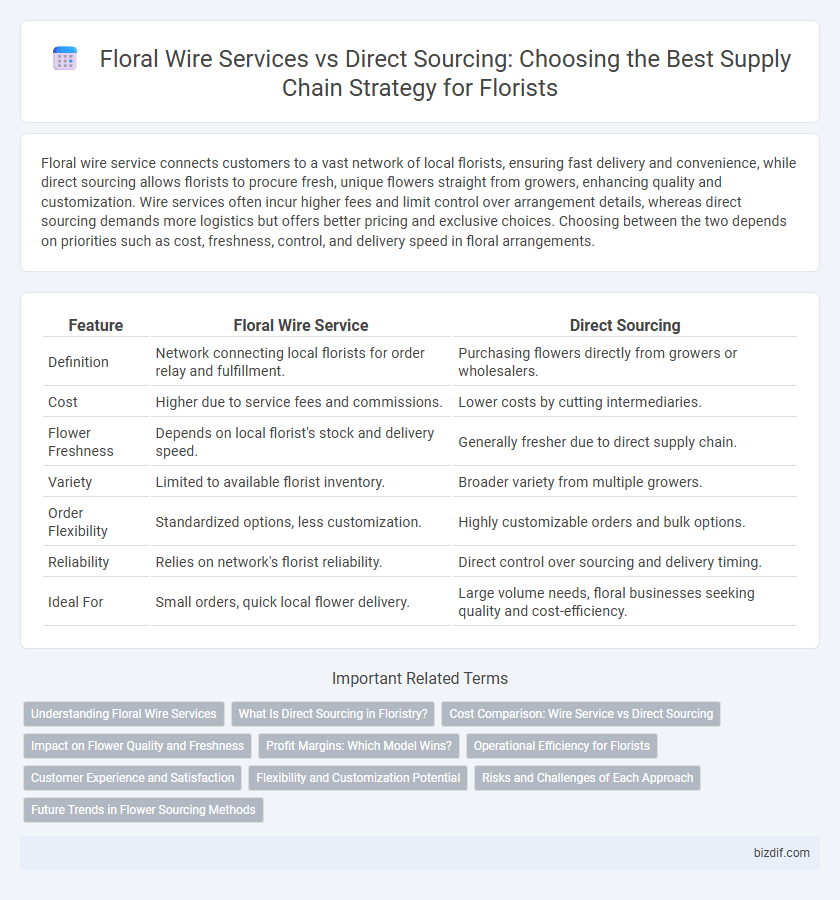Floral wire service connects customers to a vast network of local florists, ensuring fast delivery and convenience, while direct sourcing allows florists to procure fresh, unique flowers straight from growers, enhancing quality and customization. Wire services often incur higher fees and limit control over arrangement details, whereas direct sourcing demands more logistics but offers better pricing and exclusive choices. Choosing between the two depends on priorities such as cost, freshness, control, and delivery speed in floral arrangements.
Table of Comparison
| Feature | Floral Wire Service | Direct Sourcing |
|---|---|---|
| Definition | Network connecting local florists for order relay and fulfillment. | Purchasing flowers directly from growers or wholesalers. |
| Cost | Higher due to service fees and commissions. | Lower costs by cutting intermediaries. |
| Flower Freshness | Depends on local florist's stock and delivery speed. | Generally fresher due to direct supply chain. |
| Variety | Limited to available florist inventory. | Broader variety from multiple growers. |
| Order Flexibility | Standardized options, less customization. | Highly customizable orders and bulk options. |
| Reliability | Relies on network's florist reliability. | Direct control over sourcing and delivery timing. |
| Ideal For | Small orders, quick local flower delivery. | Large volume needs, floral businesses seeking quality and cost-efficiency. |
Understanding Floral Wire Services
Floral wire services act as intermediaries connecting local florists with customers nationwide by transmitting floral orders electronically, ensuring timely delivery and a consistent customer experience. They leverage extensive networks and standardized processes to facilitate efficient order routing and payment management, reducing logistical challenges for individual florists. Understanding the operational framework and fee structures of floral wire services helps florists optimize profit margins while expanding their market reach.
What Is Direct Sourcing in Floristry?
Direct sourcing in floristry involves purchasing flowers and supplies directly from growers or wholesalers, eliminating intermediaries to enhance freshness and reduce costs. This method ensures better control over product quality, availability, and customization, allowing florists to select unique or seasonal varieties tailored to specific arrangements. By bypassing floral wire services, florists can establish closer relationships with suppliers, resulting in improved reliability and cost-efficiency.
Cost Comparison: Wire Service vs Direct Sourcing
Floral wire service typically involves higher costs due to service fees and commission charges from intermediary networks, while direct sourcing allows florists to purchase flowers straight from growers at wholesale prices, reducing expenses. Direct sourcing offers greater control over product quality and pricing but requires established supplier relationships and logistical management. Cost savings from direct sourcing can be significant for large orders, whereas wire services provide convenience and broader delivery options at a premium.
Impact on Flower Quality and Freshness
Floral wire services rely on a network of third-party florists to fulfill orders, which can lead to variability in flower quality and freshness due to handling and transit times. Direct sourcing allows florists to obtain flowers straight from growers, ensuring optimal freshness and consistent quality by reducing the time from harvest to delivery. Consequently, direct sourcing enhances customer satisfaction through superior flower longevity and appearance compared to wire service arrangements.
Profit Margins: Which Model Wins?
Floral wire services typically charge a commission of 25% to 40% on orders, significantly impacting profit margins for florists. Direct sourcing eliminates middlemen, allowing florists to purchase flowers and supplies at wholesale prices, often improving margins by 10% to 20%. Higher control over inventory and reduced fees in direct sourcing consistently lead to better profitability compared to reliance on floral wire services.
Operational Efficiency for Florists
Floral wire services streamline order processing by connecting florists to a vast network, reducing delivery times and simplifying customer management. Direct sourcing offers greater control over flower quality and inventory but requires more hands-on management and longer procurement lead times. Balancing these approaches can enhance operational efficiency, allowing florists to optimize supply chain responsiveness and maintain service reliability.
Customer Experience and Satisfaction
Floral wire services offer customers convenience and a wide network of florists, ensuring fast delivery and diverse floral options, which enhances satisfaction for last-minute or remote orders. Direct sourcing provides personalized arrangements with higher quality control and often fresher flowers, creating a more unique and tailored customer experience. Prioritizing direct sourcing can lead to improved customer loyalty due to the distinctive and locally curated floral designs that align with specific client preferences.
Flexibility and Customization Potential
Floral wire services offer high flexibility by connecting local florists through a widespread network, enabling quick order fulfillment across diverse geographic locations. However, direct sourcing provides greater customization potential as florists can select unique, high-quality flowers and materials directly from growers or wholesalers, tailoring arrangements to specific customer preferences. While wire services excel in speed and convenience, direct sourcing empowers florists with control over floral varieties, seasonal availability, and creative design choices.
Risks and Challenges of Each Approach
Floral wire services offer convenience and broad reach but carry risks such as high service fees, inconsistent quality control, and dependency on network reliability. Direct sourcing provides greater control over product quality and pricing but involves challenges like complex supplier vetting, logistical coordination, and potential supply chain disruptions. Each approach demands careful risk management to balance cost, consistency, and customer satisfaction in floristry operations.
Future Trends in Flower Sourcing Methods
Future trends in flower sourcing methods emphasize digital integration and sustainability, with floral wire services increasingly adopting AI-driven platforms to enhance real-time inventory management and optimize delivery routes. Direct sourcing will benefit from blockchain technology, ensuring transparency and traceability from farm to florist, appealing to eco-conscious consumers. Both methods will leverage automation and data analytics to reduce waste, improve quality control, and respond swiftly to market demand fluctuations.
Floral Wire Service vs Direct Sourcing Infographic

 bizdif.com
bizdif.com